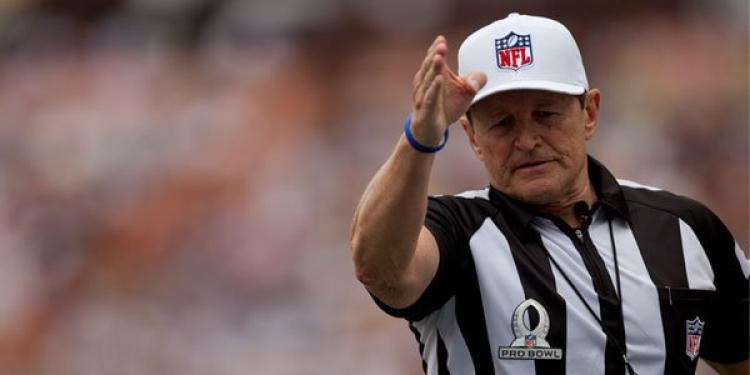NFL Rules for Beginners – The Super Bowl Guide (PART III)
Posted: February 4, 2016
Updated: June 5, 2017

Referee Super Bowl GuideHere is the final part of our basic NFL rules guide discussing officiating, penalties and game clock policy in the NFL.
- How reviews work in NFL?
- What is a foul in the NFL?
- How game clock works in NFL?
Read the final part of our basic NFL rules guide to be aware of the role of the officials, what are the fouls and how they are penalized and how the game clock works in NFL. These rules are very important for any fan or internet betting player trying to understand the game.
The Officials and the reviews in NFL
There are seven officials for each game in the NFL. They are supported by a media crew, who help them to review certain situations. These are scoring plays, turnovers and controversial situations in the last two minutes of the halves and in overtime.
There is also the coaches’ challenge for measurable decisions made by the officials. This is activated by the head coach throwing a red flag onto the field. He can do that twice in a game and also a third time if he was right on both occasions. However he loses one of his timeouts if he was wrong.
The most important of the officials is the referee. He wears a white cap and he announces official decisions regarding penalties and reviews for the crowd via his micro-port and using hand signals. This is a great feature for any sports fan or those who bet on sports in the US and worldwide.
What is a foul in the NFL? – Basic NFL rules
Fouls are signaled by the officials throwing a yellow flag onto the field, marking the spot of the foul. There are so many types of fouls in the NFL that it is impossible to discuss everything in one piece. Some of them are even obscure for players and coaches, and sometimes even the officials themselves are in trouble with them. Therefore in our basic NFL rules guide we only mention the most common and most important fouls that are vital to know for those who are involved in internet betting in the EU.
Penalties in the NFL
In the NFL, fouls are penalized with loss of yards. Conceding too many penalties and therefore giving up too many yards easily can be a decisive factor in the game. A minor foul cost 5 yards for the fouling team, while the biggest offenses are 15-yard penalties. Let’s see the most important fouls by penalties in our basic NFL rules guide!
5-yard penalties in the NFL
5-yard penalties are minor fouls. These are usually offside-like and similar fouls before the play has started, like Too many men on the field. Delay of game is an action that delays the start of the play, usually the offense fails to start the play in time. False start is called on the offense many times, since the offense players cannot move from their starting position except one ’motion’ player.
Similar defensive fouls are Encroachment, Neutral Zone Infraction and Offside, since the defenders can move prior to the start of the play, but cannot cross the line of scrimmage. (Actually they can, but can’t force the offense players to move and they have to return to their side before the ball has snapped.)
There are other offense penalties for five yards, since it is strictly regulated how they can set up and who can catch the ball. Illegal formation is called when fewer than 7 offense players are standing on the line of scrimmage. From that seven, only the two on each ends can catch a pass (usually the two wide receivers or one receiver and the tight end), plus the running back(s). These five players are the only ‘eligible receivers’. If any other player touches the pass first, Illegal touching a forward pass is called.
It is important to note in our basic NFL rules guide that offenses can make only one forward pass attempt per plays and only from behind the line of scrimmage. Otherwise it is an Illegal forward pass.
10-yard penalties in the NFL
Ten yard penalties are also common in the NFL, and there are a lot of types of them, but we only list the most important ones in our basic NFL rules guide.
Holding is maybe the most important and common penalty in our basic NFL rules guide. It means that a player pulls his opponent other than the ballcarrier in an illegal way. It is usually called on offensive linemen trying to obstruct defensive players chasing the quarterback.
Illegal batting – it is good to know, that you can’t bat a loose ball (after a fumble) in any direction.
Intentional grounding is a very interesting and sometimes controversial rule. The quarterback can only throw away the ball to avoid a sack and losing a lot of yards, when he moved sideways from behind his O-line and the ball reaches the line of scrimmage.
Pass interference – another very common and important foul in our basic NFL rules guide. Intentional physical contact can’t be made in order to obstruct the opponent from catching the ball after a pass is thrown and before the ball was touched by any other player. When this occurs before the ball has been thrown by the quarterback, Illegal contact is called and that is a five-yard penalty.

The quarterback has unique injuries compared to other players
15-yard penalties in the NFL
15-yard penalties are usually called on unsportsmanlike and/or dangerous movements which can cause injuries. There are many types of illegal blocking which are penalized with a 15-yard penalty. We won’t list them individually in our basic NFL rules guide.
Face mask – intentionally grabbing and pulling the facemask of the opponent.
Helmet-to-helmet collision – crashing into the opponents helmet, if the opponent is not a ballcarrier. Sometimes it is controversial if a receiver is already a runner or not, since they are protected until they completed the catch, but after that they qualify as runners. This collision is no foul if made against the runner, however, in any other situation it can trigger a fine or a suspension too.
Horse-collar tackle – grabbing the runners shoulderpads from behind and pulling him down illegally.
Personal foul – any foul which is made after the play is over, or during the play like unnecessary roughness. The fouling player can be ejected from the game in excessive situations.
Roughing the passer – the quarterback can be hit just after he released the ball, under the head-neck area. If the defensive player makes two or more steps after the ball was thrown and still hits the QB, he commits a roughing the passer foul.
Unsportsmanlike conduct – coaches or players behaving in an intolerable manner, usually using abusive language. This also includes taunting and excessive celebrations which is many times controversial for fans and players.
How does the game clock work in the NFL?
Game clock policy in the NFL is tricky and it is responsible for a 60 minute-long game going for over three hours. The game clock stops many times during an NFL game and it is easy to learn the main guidelines. We discuss the most important game clock rules in our basic NFL rules guide, but don’t list all the weird rules.
Game clock stops:So, the game clock naturally stops at timeouts (3 per halves for each team), penalties, coaches’ challenges and scoring plays. Injuries and official reviews (scoring plays, turnovers) also stop the game clock. The game clock also stops automatically two minutes before the end of the halves, this is the two-minute-warning.
- Incomplete pass
- Ballcarrier goes out of bounds
- Timeout
- Injury
- Penalty
- Official review
- Scoring play
- Two-minute-warning
Players’ actions can also stop the game clock. The game clock stops after an incomplete pass attempt and when the ballcarrier goes out of bounds (leaves the field). This is important, because teams and coaches can manage the clock with their play-calling. A leading team can eat up time by calling running plays in the middle. At the same time a team trailing can save time by calling a lot of passing plays.
Clock management can be a deciding factor in NFL games, so this is a vital skill for head coaches to be successful in professional football.
Also check out the first two parts of our basic NFL rules guide!
NFL Rules for Beginners – The Super Bowl Guide (PART I)
NFL Rules for Beginners – The Super Bowl Guide (PART II)
Related content
Subscribe
0 Comments












